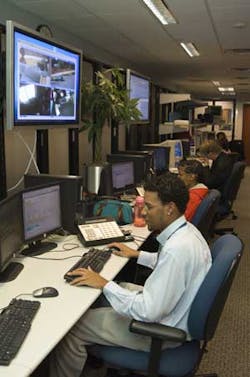Inside the Heart of ADT's National Monitoring Center in Aurora, Co.
Aurora, CO – As you walk into the nerve center of ADT’s national account monitoring center in Aurora, you are immediately struck by its vastness and silence. This would not be such a shock if it weren’t for the fact that this huge well-lit open space contains 300 service reps all busy on telephones interacting with customers and supervisors scurrying from station to station monitoring the staff. This silence amongst the chaos of security incidents characterizes the strict regimen each employee in the center has adopted to help make the operation one of the most impressive of its kind.
Masked by a “white noise†apparatus in the central monitoring service area, the hush belies the urgency of the business at hand. The Aurora Center, which is the headquarters of ADT’s domestic monitoring operations, is one of five major facilities in the US. Others are housed in Omaha, Rochester, Kansas City and Jacksonville. It was in the mid-1990s when ADT decided to move away from its small regional call centers into the present mega-center arrangement.
For Craig Sparkman, the executive director of national accounts monitoring centers, the move was an essential driver in ADT taking the next step in meeting customer demands.
“We are now able to have traffic moved to the alarm center venue that is most effective to meet the needs of the incident. It has also allowed us a high-level of redundancy to move customers caught in events like hurricanes or power outages,†said Sparkman, citing hurricane Katrina and the 1994 New York City blackout as real-life examples of how the ADT redundant system has worked.
The monitoring center is divided into four major workgroups. The “Outbound†emergency dispatch operators handle alarm monitoring and notification. The “Inbound†customer service specialist deal with customer issues, problems and complaints. The technical assistance specialists are present to solve technology and system issues, while the fourth group provides data management and down line loading exclusive to ADT’s commercial accounts.
A typical day at the national account monitoring center is staggering. The center will handle more than 6,000 duress, fire or burglary calls; 3,500 supervisory alarms or trouble signals; around 7,500 schedule-related alarms that include fail-to-open and fail-to-close alarms; 6,000 customer service calls, and another 2,300 technical assistance calls.
“If you just look at the numbers by themselves, the workload is potentially overwhelming. But that is why the training we put our employees through is so intense. We want them to have experience in every type of alarm and response scenario before they are ever allowed on the main floor,†said Sparkman, who runs three shifts of 125 people twenty-four/seven. “After two weeks of intensive training, all customer service personnel must pass a 21-point review and then they graduate as a group to the main floor. But even then, they are still heavily monitored during their first year.â€
These new “recruits†are assigned to the outbound or inbound monitoring stations only for the first year and follow a strict script. They are not allowed to move into the specialized service areas in commercial or high-end monitoring environments until proving themselves under fire on the main floor.
While the volume of alarm scenarios are seemingly overwhelming, management’s expectations for performance is even more daunting, according to Sparkman. He related that his team is able to respond to 85 percent of inbound and technical assistance calls within 18 seconds and 90 percent of high priority alarms within a minute. Other alarm response times are just as stringent, he adds.
When it comes to high security customers and high risk facilities, ADT brings in Brian Atkins and his “Special Operations†group. This contingent manages critical infrastructure operations, banking and financial concerns, federal and municipal government agencies and high-profile executive clients. All special ops personnel have high security clearance.
This specialized group has unique remote monitoring and security control capabilities that allow for remote access control functionality, remote video surveillance, emergency communication options, alarm video verification and remote video escort service.
“This is almost like the military’s special forces unit,†said Atkins, as he pointed to the staff manning their high-tech stations in a glass enclosed emergency center away from the main monitoring floor. “These people are the best in the industry and can deal with virtually any crisis, at any level.â€
The special ops unit is also responsible for ADT’s SelectVision package that handles remote guard monitoring, which, according to Atkins, is evolving into one of the prime service drivers on the commercial and retail side. Basically the customer is able to set the alarm condition parameters and fail criteria for their respective facilities. So any incident from a propped door to a guard out of uniform would trigger a response. The client is also provided a weekly guard audit report to track guard traffic and incident responses.
Stepping into the data center, at the heart of the Aurora facility, stacks and rows of servers, routers and storage units resemble a small city skyline. The network infrastructure accommodates thousands of servers and just as many Cisco routers. Capacity has grown from a projected one million customers at the Aurora center to more than two million in short order. And across the remaining four national centers, ADT handles more than six million customers.
“The goal here is to meet every event scenario possible and respond accordingly,†added Sparkman. “Our technology is only as good as our people and we think we have the best of both worlds.â€
